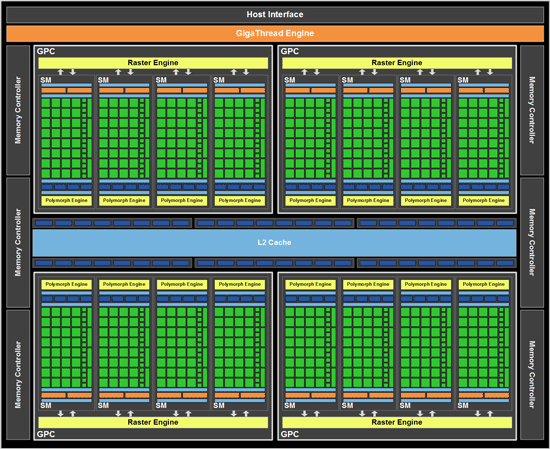NVIDIA's GeForce GTX 580: Fermi Refined
by Ryan Smith on November 9, 2010 9:00 AM ESTGF110: Fermi Learns Some New Tricks
We’ll start our in-depth look at the GTX 580 with a look at GF110, the new GPU at the heart of the card.
There have been rumors about GF110 for some time now, and while they ultimately weren’t very clear it was obvious NVIDIA would have to follow up GF100 with something else similar to it on 40nm to carry them through the rest of the processes’ lifecycle. So for some time now we’ve been speculating on what we might see with GF100’s follow-up part – an outright bigger chip was unlikely given GF100’s already large die size, but NVIDIA has a number of tricks they can use to optimize things.
Many of those tricks we’ve already seen in GF104, and had you asked us a month ago what we thought GF110 would be, we were expecting some kind of fusion of GF104 and GF100. Primarily our bet was on the 48 CUDA Core SM making its way over to a high-end part, bringing with it GF104’s higher theoretical performance and enhancements such as superscalar execution and additional special function and texture units for each SM. What we got wasn’t quite what we were imagining – GF110 is much more heavily rooted in GF100 than GF104, but that doesn’t mean NVIDIA hasn’t learned a trick or two.
Fundamentally GF110 is the same architecture as GF100, especially when it comes to compute. 512 CUDA Cores are divided up among 4 GPCs, and in turn each GPC contains 1 raster engine and 4 SMs. At the SM level each SM contains 32 CUDA cores, 16 load/store units, 4 special function units, 4 texture units, 2 warp schedulers with 1 dispatch unit each, 1 Polymorph unit (containing NVIDIA’s tessellator) and then the 48KB+16KB L1 cache, registers, and other glue that brought an SM together. At this level NVIDIA relies on TLP to keep a GF110 SM occupied with work. Attached to this are the ROPs and L2 cache, with 768KB of L2 cache serving as the guardian between the SMs and the 6 64bit memory controllers. Ultimately GF110’s compute performance per clock remains unchanged from GF100 – at least if we had a GF100 part with all of its SMs enabled.
On the graphics side however, NVIDIA has been hard at work. They did not port over GF104’s shader design, but they did port over GF104’s texture hardware. Previously with GF100, each unit could compute 1 texture address and fetch 4 32bit/INT8 texture samples per clock, 2 64bit/FP16 texture samples per clock, or 1 128bit/FP32 texture sample per clock. GF104’s texture units improved this to 4 samples/clock for 32bit and 64bit, and it’s these texture units that have been brought over for GF110. GF110 can now do 64bit/FP16 filtering at full speed versus half-speed on GF100, and this is the first of the two major steps NVIDIA took to increase GF110’s performance over GF100’s performance on a clock-for-clock basis.
| NVIDIA Texture Filtering Speed (Per Texture Unit) | |||||
| GF110 | GF104 | GF100 | |||
| 32bit (INT8) | 4 Texels/Clock | 4 Texels/Clock | 4 Texels/Clock | ||
| 64bit (FP16) | 4 Texels/Clock | 4 Texels/Clock | 2 Texels/Clock | ||
| 128bit (FP32) | 1 Texel/Clock | 1 Texel/Clock | 1 Texel/Clock | ||
Like most optimizations, the impact of this one is going to be felt more on newer games than older games. Games that make heavy use of 64bit/FP16 texturing stand to gain the most, while older games that rarely (if at all) used 64bit texturing will gain the least. Also note that while 64bit/FP16 texturing has been sped up, 64bit/FP16 rendering has not – the ROPs still need 2 cycles to digest 64bit/FP16 pixels, and 4 cycles to digest 128bit/FP32 pixels.
It’s also worth noting that this means that NVIDIA’s texture:compute ratio schism remains. Compared to GF100, GF104 doubled up on texture units while only increasing the shader count by 50%; the final result was that per SM 32 texels were processed to 96 instructions computed (seeing as how the shader clock is 2x the base clock), giving us 1:3 ratio. GF100 and GF110 on the other hand retain the 1:4 (16:64) ratio. Ultimately at equal clocks GF104 and GF110 widely differ in shading, but with 64 texture units total in both designs, both have equal texturing performance.
Moving on, GF110’s second trick is brand-new to GF110, and it goes hand-in-hand with NVIDIA’s focus on tessellation: improved Z-culling. As a quick refresher, Z-culling is a method of improving GPU performance by throwing out pixels that will never be seen early in the rendering process. By comparing the depth and transparency of a new pixel to existing pixels in the Z-buffer, it’s possible to determine whether that pixel will be seen or not; pixels that fall behind other opaque objects are discarded rather than rendered any further, saving on compute and memory resources. GPUs have had this feature for ages, and after a spurt of development early last decade under branded names such as HyperZ (AMD) and Lightspeed Memory Architecture (NVIDIA), Z-culling hasn’t been promoted in great detail since then.

Z-Culling In Action: Not Rendering What You Can't See
For GF110 this is changing somewhat as Z-culling is once again being brought back to the surface, although not with the zeal of past efforts. NVIDIA has improved the efficiency of the Z-cull units in their raster engine, allowing them to retire additional pixels that were not caught in the previous iteration of their Z-cull unit. Without getting too deep into details, internal rasterizing and Z-culling take place in groups of pixels called tiles; we don’t believe NVIDIA has reduced the size of their tiles (which Beyond3D estimates at 4x2); instead we believe NVIDIA has done something to better reject individual pixels within a tile. NVIDIA hasn’t come forth with too many details beyond the fact that their new Z-cull unit supports “finer resolution occluder tracking”, so this will have to remain a mystery for another day.
In any case, the importance of this improvement is that it’s particularly weighted towards small triangles, which are fairly rare in traditional rendering setups but can be extremely common with heavily tessellated images. Or in other words, improving their Z-cull unit primarily serves to improve their tessellation performance by allowing NVIDIA to better reject pixels on small triangles. This should offer some benefit even in games with fewer, larger triangles, but as framed by NVIDIA the benefit is likely less pronounced.
In the end these are probably the most aggressive changes NVIDIA could make in such a short period of time. Considering the GF110 project really only kicked off in earnest in February, NVIDIA only had around half a year to tinker with the design before it had to be taped out. As GPUs get larger and more complex, the amount of tweaking that can get done inside such a short window is going to continue to shrink – and this is a far cry from the days where we used to get major GPU refreshes inside of a year.











160 Comments
View All Comments
AnnonymousCoward - Wednesday, November 10, 2010 - link
I'm with you, that AMD still has a superior performance per power design. But with the 580, nvidia took Fermi from being outrageous to competitive in that category, and even wins by a wide margin with idle power. Looking at the charts, the 580 also has a vastly superior cooling system to the 5970. Mad props to nvidia for turning things around.FragKrag - Tuesday, November 9, 2010 - link
Still no SC2? :(Ryan Smith - Tuesday, November 9, 2010 - link
Honestly, I ran out of time. I need to do a massive round of SC2 benchmarking this week, at which time it will be in all regular reviews and will be in Bench.ph3412b07 - Tuesday, November 9, 2010 - link
There is always some debate as to the value of single gpu solutions vs multi gpu. I've noticed that the avg/max framerate in multi gpu setups is in fact quite good in some cases, but the min fps paints a different picture, with nearly all setups and various games being plagued by micro-stutter. Has anybody else come across this as reason to go with a more expensive single card?eXces - Tuesday, November 9, 2010 - link
Why did u not include some overclocked 5970? Like u did with GTX 460 when u reviewed 6800 series?Ryan Smith - Wednesday, November 10, 2010 - link
If you don't recall from our 5970 review, we disqualified our 5970 when running at 5870 clocks. The VRMs on the 5970 cannot keep up with the power draw on some real world applications, so it does not pass our muster at those speeds by even the loosest interpretation.529th - Tuesday, November 9, 2010 - link
I knew OCCT was a culprit of causing problems.Ph0b0s - Tuesday, November 9, 2010 - link
Was very interested to look at the review today to see how the new GTX580 and other DX11 card options are in comparison to my GTX 285 SLI setup. But unfortunately for the games I am playing BFBC2, Stalker etc and would base my descition on, I still don't know as my card is not represented. I know why,, becuase they are DX11 games and my card is DX10, but my card still runs them and I would want to know how they compare even if one is running DX10 and the other running DX11. Even Anandtech's chart system gives no measure for my cards in these games . Please sort this out. Just becuase a card does not run the latest version of directx does not mean it should be forgotten. Escpecially since the people most likley to be looking at upgrading are those with this generation of card rather than people with DX 11 hardware...mapesdhs - Wednesday, November 10, 2010 - link
Don't worry, I'll have some useful info for you soon! 8800GT vs. 4890 vs. 460, in all
three cases testing 1 & 2 cards. You should be able to eaisly extrapolate from the
results to your GTX285 vs. 580 scenario. Send me an email (mapesdhs@yahoo.com)
and I'll drop you a line when the results are up. Data for 8800 GT vs. 4890 is already up:
http://www.sgidepot.co.uk/misc/pctests.html
http://www.sgidepot.co.uk/misc/stalkercopbench.txt
but I'm adding two more tests (Unigine and X3TC).
Ian.
juampavalverde - Tuesday, November 9, 2010 - link
NVIDIA exceed AMD with this... as long as the barts should have been 6770, this fermi slight improvement just in this universe can be called 5xx series. it is just the gf100 done right, and should have been named properly, as gtx 490.